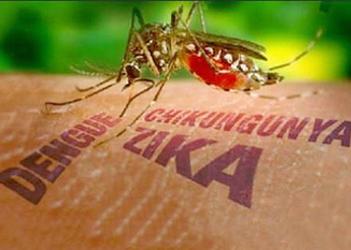
BRUSSELS, Belgium, March 19, 2018 (ENS) – Enabled by climate change, international travel and international trade, disease-bearing insects are spreading to ever-wider parts of the world. They have existed in Africa and Asia for many years and are now becoming more widespread.
This means that more humans than ever before are exposed to viral infections such as Dengue fever, Chikungunya, Zika, West Nile fever, Yellow fever and Tick-borne encephalitis.
For many of these diseases, there are as yet no specific antiviral agents or vaccines.

Global warming has allowed mosquitoes, ticks and other disease-bearing insects to proliferate, adapt to different seasons, migrate and spread to new niche areas that have become warmer.
These are the findings of a new report from the European Commission Joint Research Centre, JRC, that aims to raise awareness about the threat posed by the spread of arboviruses, also called arthropod-borne viruses.
Aedes mosquitoes spread several arboviruses, including Dengue, Chikungunya, Zika, West Nile and Yellow fever viruses.
These mosquitoes thrive in urban settings due to the lack of natural predators and the ready availability of food and habitats in which to breed.
They have recently become established in some European countries and the Americas as a result of international travel and trade.
“Their alarming spread poses a problem for public health. They are difficult to eradicate – their larvae can survive for months, even in suboptimal humidity and temperature conditions,” the JRC reports.
The tick-borne encephalitis virus, TVEV, has been found in several European countries, including Austria, the Czech Republic, Germany, Lithuania, Poland, Slovakia, Sweden and, more recently, the Netherlands.
A newly recognized vector for the virus, the Dermacentor reticulatus tick species, is rapidly spreading through Europe. It has a high reproduction rate, is cold resistant and can live underwater for months.
Humans can be infected by a tick bite or through consuming unpasteurized dairy products that do not meet EU safety standards and have come from infected animals. There is a vaccine for TBEV.
Zika virus has received a lot of media attention due to its association with neurological disorders such as Guillain-Barré Syndrome and the development of microcephaly, an abnormally small head, in fetuses.
Zika virus is difficult to diagnose and there is no cure or vaccine. First identified in 1947 in the Zika forest of Uganda, its spread is a serious concern given the growing presence in temperate zones including Europe and America of its main vector, the mosquito Aedes albopictus.
The first documented outbreak of Zika virus infection was reported in 2007 in Micronesia. Since then it has spread to French Polynesia and Brazil, where it infected up to 1.3 million people in 2015.
More than 70 territories worldwide have confirmed indigenous cases of Zika virus. By March 2017, 2,130 Europeans were reported to have travel-associated Zika infections.
Mosquito control strategies
The report describes and discusses several methods that have been used to control the spread of mosquitoes, including insecticides, mosquito traps, genetic modification, land reclamation and habitat surveillance.
Currently, the safest and most readily available and effective methods of controlling mosquitoes are mosquito traps for relatively small areas and nets, and the reduction of potential breeding sites such as standing water.
While the research team behind the study advocate better control of mosquito populations, they also warn that it would be unwise to remove mosquitoes completely from the ecosystem.
They are part of the food web for some species, and pollinate many plants. Wiping them out completely could have negative effects on nature, and consequently on humans.
Copyright Environment News Service (ENS) 2018. All rights reserved.
